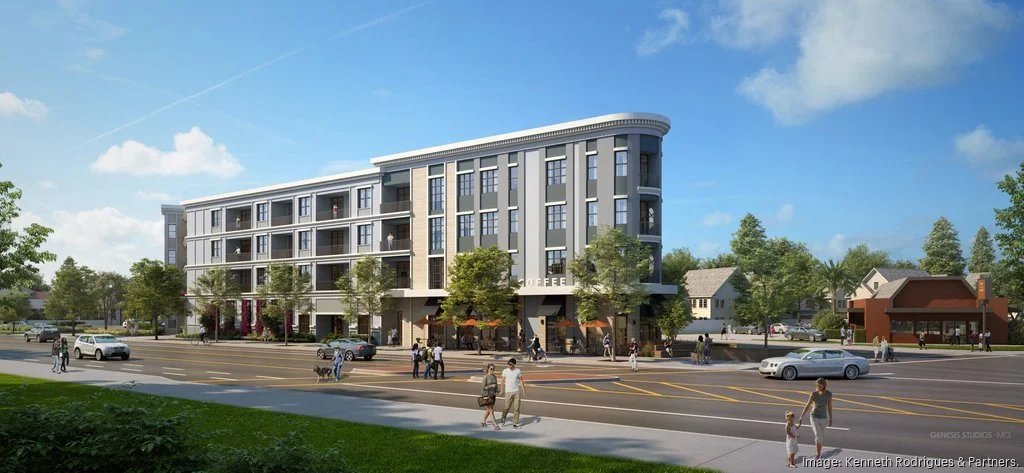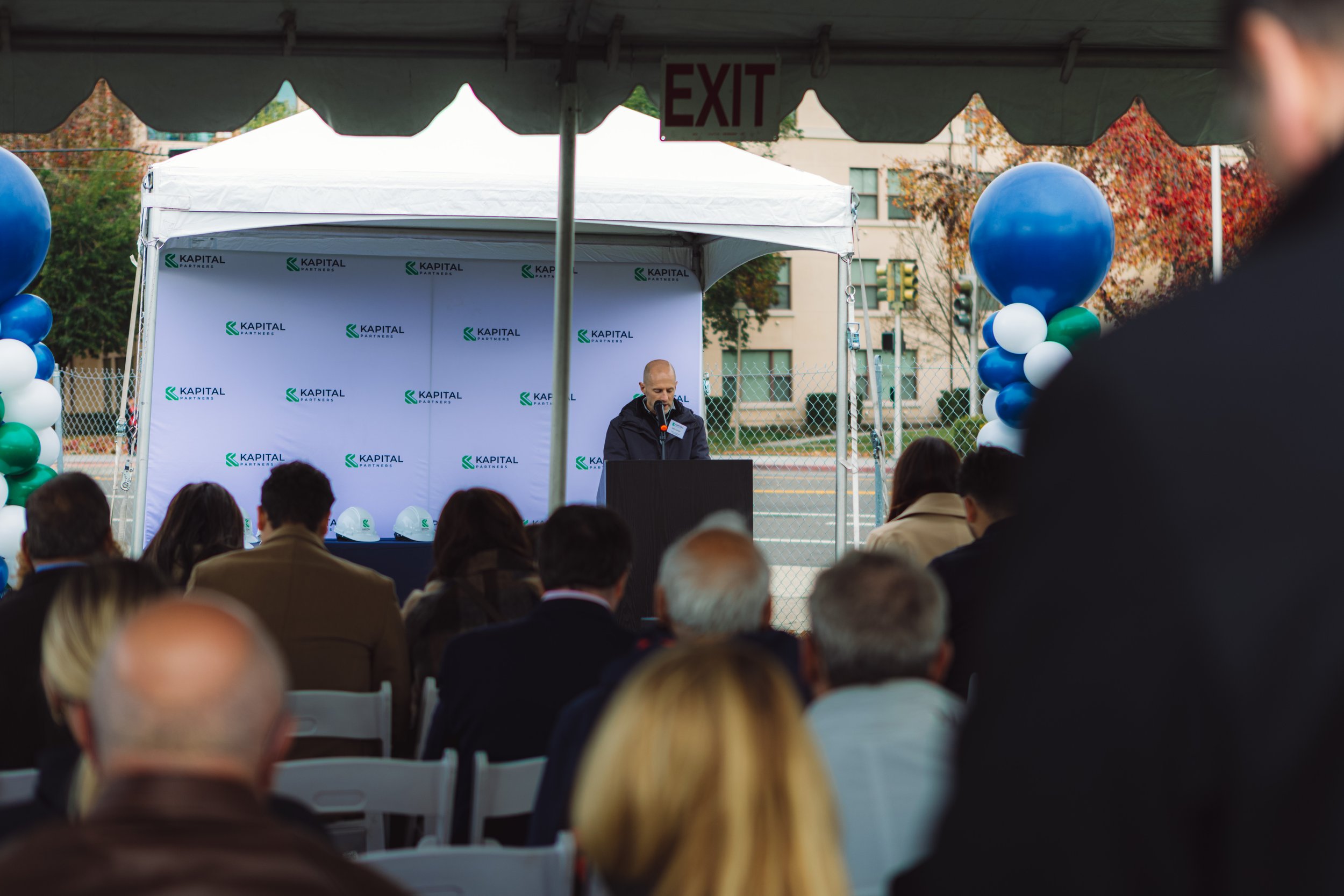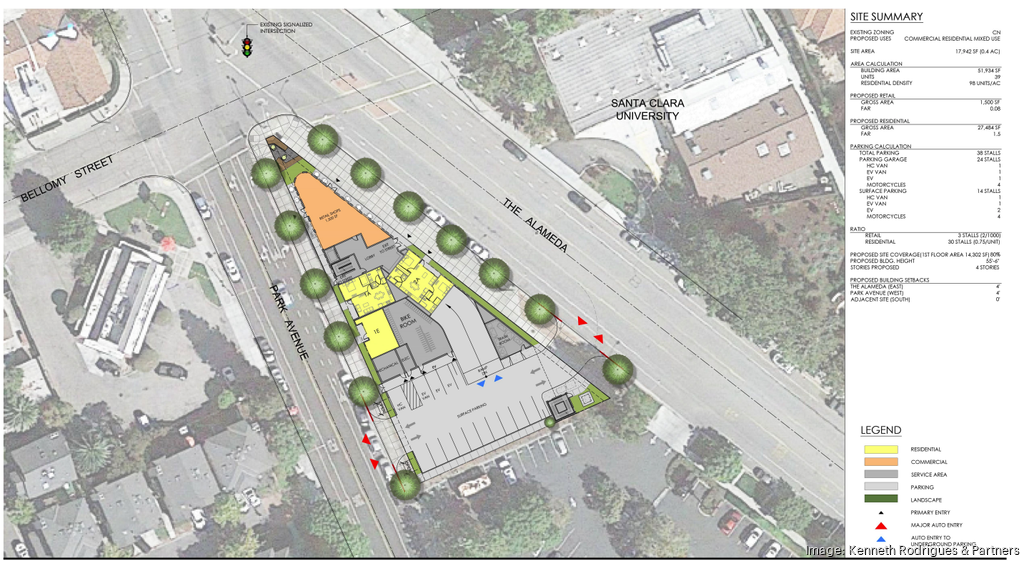From Vacant to Vibrant as Alum Builds New Apartments
Kapital Partners looks to construct a four-story mixed-use building on the empty lot next to SafeWay
Design provided by Kenneth Rodrigues & Partners
A triangular lot that has sat vacant since 1991 will soon transform into a four-story apartment complex, marking the first new student-oriented housing development near Santa Clara University's south campus in decades.
“Nobody ever thought that you would be able to develop anything on this land, ever. It has been vacant for so long,” said City of Santa Clara Mayor Lisa Gilmore at the groundbreaking ceremony back in December of 2024. “It's really going to complete the area plan around the University and keep the students close to the University in a safe location.”
Photo by Dylan Ryu.
Matthew Carnes, the Vice President for Mission and Ministry, leads a prayer at Ground Breaking event to bless the land
Santa Clara County Supervisor Susan Ellenberg emphasized the broader housing needs. “Every time a city and a council says yes to building housing, it helps us to address the overwhelming crisis of affordable housing that we have here in Santa Clara County, as well as across the state,” she said.
Construction will begin in early 2025 on the 34-unit building at 2655 The Alameda. The project, which received city council approval in a 6-1 vote last August, represents a personal mission for developer Anjuli Nanda Habbas ’14 J.D. ’17, partner of Kapital Partners.
“I found out that this site was for sale, and I sent it to my dad,” Habbas said at the groundbreaking ceremony, “then ensued our year long negotiation with the behemoth that is Chevron Corporation, who owned this lot.” Just over a year later, Habbas and Kapital Partners would purchase the land for $1 million.
For Habbas, a Santa Clara University alum with both undergraduate and law degrees from the University, the project represents a chance to address housing issues she experienced firsthand. “As a Bronco myself, I know how competitive it was to live off campus,” she said. “People are applying, you know, over a year ahead of time for a lease that is a year out.”
The development will feature ground-floor retail space, an interior courtyard, and 38 parking spaces split between underground and surface lots. Habbas estimated that construction would take 16 months to complete.
The project faced challenges beyond acquisition. “We had to do a general plan amendment to allow for housing to go on the site because it was not previously zoned for residential use,” Habbas said in an interview with The Santa Clara.
The land was home to a former Chevron gas station, and required environmental remediation before construction could begin. “When you are deemed a contaminated parcel, like we were because of the underground storage tanks that were removed 30 years ago, you come under the jurisdiction of two agencies in the state of California—the department of environmental health or the state water board,” Habbas explained.
The cleanup process is strictly regulated. “We are under the jurisdiction of the department of environmental health, and they basically direct you as to how to remediate the site and when the site will become classified as no longer hazardous,” she said. “It’s all very heavily state or county regulated. It’s not like I, as an individual, get to decide what I want to do with the property. It’s all overseen by a legislative body of experts who can say when you can build, when you can occupy the property.”
All remediation efforts and progress reports are publicly available on GeoTracker, a state-run environmental database.
Design provided Kenneth Rodrigues & Partners
Due to the development's close proximity to campus, those who usually drive on the Alameda may be disrupted, particularly if there are any potential road closures. “I'm sure throughout the 16 months there will be times where they will have to close the line or two,” said Habbas. “But those closures will require an encroachment permit through the city, so there will be traffic plans submitted, and traffic cones and an attendant to help people navigate the closure and when that occurs.”
Jack Gerwe ’28, Associated Student Government’s representative for Transportation Services, has weighed the benefits and drawbacks to the new development. “This development could be beneficial to students and can provide additional parking, but the road closure could impact business at Safeway and other stores on The Alameda,” said Gerwe. “If the road closes for an extended period of time, it could affect commuters and students with vehicles who live in Finn. Luckily, the VTA buses do not go through that part of the Alameda, so commuter students or other students who rely on those modes of public transportation will hopefully be unaffected.”
The development has sparked debate about its community benefit. “I feel like it’s designed for and aimed at students,” San José Councilmember Kevin Park said, according to an article from the San José Spotlight. “If we ask for a general plan amendment, it ought to be something better than what the general plan offers. I don’t see the benefit to the community here.”
Habbas directly challenged Park’s assessment. “I think he’s respectfully out of touch with the students of Santa Clara University,” she said. “The student body right now is living in mostly dilapidated homes that are not upgraded, that are not entirely clean and are packing several people in a single room.” Habbas further explained that many landlords and the University do not regularly update non-dorm housing, like the neighborhood units.
“Kevin is not in touch, or familiar, or out there actually talking to students, because if he was, he would have a different perception.” Habbas said. “It’s easy to sit back from the council chambers on Warburton Avenue and not know how much benefits this project brings, but if you walk the streets of Bellomy Street and streets in your city and talk to students, I think you get the feedback of the current state of the housing on that side of campus, the lack of off campus housing.”
Gerwe similarly saw the development as having more benefits to the University than cons. “Not only will the area add more parking, but it will also likely encourage drivers to slow down in that part of the Alameda. If a number of students do end up living in the apartment, the City of Santa Clara may be incentivized to add more crosswalks and pedestrian traffic lights. This will create a safer environment for the students and the community,” he said.
However, Gerwe recognized that people like Park do not agree with the development. “It feels like this project is benefitting the students of Santa Clara much more than the City of Santa Clara as a whole, and I think that is why some residents of Santa Clara are not happy with it.” he said.


